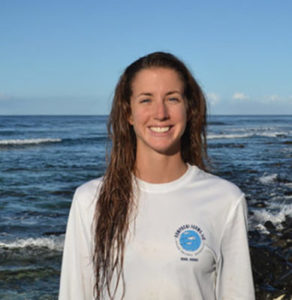Where will aquaculture be in 10 years?
Editor’s note: The following is a guest blog post by one of GAA’s 30 Under 30 members, Lisa Vollbrecht. Lisa has a degree in Marine and Freshwater Biology from the University of Guelph. At Kampachi Farms in Hawaii, she supervises all research projects and provides direction and leadership to the research team. This is the fifth and final post in a five-part series by members of the 30 Under 30, in which Lisa writes about where she sees the aquaculture industry in 10 years’ time.
 As young aquaculture professionals, we have the great privilege to advance an industry that is still now in a pioneering stage. Guided by earlier explorers, we will draw from a broad range of expertise to lead the rapid expansion and diversification of global aquaculture. This industry welcomes our talents, creativity and ingenuity to meet the seafood demands of a planet with increasingly limited resources. We have an unprecedented amount of training, technology, and global connectivity available to us to solve these upcoming challenges. The possibilities are energizing. We will learn, adapt, invent, preserve and persevere.
As young aquaculture professionals, we have the great privilege to advance an industry that is still now in a pioneering stage. Guided by earlier explorers, we will draw from a broad range of expertise to lead the rapid expansion and diversification of global aquaculture. This industry welcomes our talents, creativity and ingenuity to meet the seafood demands of a planet with increasingly limited resources. We have an unprecedented amount of training, technology, and global connectivity available to us to solve these upcoming challenges. The possibilities are energizing. We will learn, adapt, invent, preserve and persevere.
Innovations are already surfacing that can guide us into a productive and sustainable future. Selective breeding technologies can dramatically improve the growth trajectory of relatively new species to aquaculture, enabling shorter culture cycles and greater yields. Proactive health management (rooted in a better understanding of nutrition, genetics, and the microbiome) and advances in alternative feedstuffs will drive best practices for years to come. Ongoing synergies of aquaculture with the fields of computer science, environmental modelling, and engineering continue to buoy us into new production models and frontiers.
In addition to the innovation that will drive our industry forward, my 10-year vision for aquaculture necessitates collaboration and responsibility.
Collaboration
Intraspecific industry coalitions will facilitate species-wide solutions to address current and looming threats unique to the culture of a particular species. These collaborations could buffer the industry from setbacks and create a scaffold for rapid responses to potential issues. At the same time, we need to foster interspecific industry collaboration to enhance cohesive aquaculture messaging across the many trophic levels being cultured globally. This collaboration would enable streamlining and integration along pathways to market, building to a future benchmark of holistic usage of harvested stock to supply existing, and yet to be discovered, applications of aquaculture products.
 Responsibility
Responsibility
Environmental responsibility urges that we align high intensity cultivation with the limitations and rhythms of the natural environment. We need healthy waters to grow healthy aquaculture products, plain and simple. We are growing the future of seafood, and we have an opportunity to inject science-driven forethought into the sustainable siting and expansion of the industry. In 10 years, my hope is that we’ll be capitalizing on our use of science-based decision and policy-making for the well-planned, responsible evolution of aquaculture. It is also our responsibility to not only “do good,” but to show it. Being transparent about our actions as farmers and operators – being proud of what we do – means also facilitating a future of open dialogue around aquaculture, which will educate and empower consumers for that moment when their number is called at the seafood counter.
In a grander sense, I’m hopeful that the delicious seafood of our industry could be a tangible way to better connect us all to the blue part of our planet – what’s under the surface – and stimulate awareness for conservation of our waters.
This isn’t just a vision through rose-coloured goggles. Our future is palpable to the industry leaders who are converging on strategies to realize the sustainable growth of global aquaculture. We are already in a movement. A moment. This is a notable hatch mark on our timeline. The future of seafood is taking shape.
If our industry timeline were a kampachi production cycle, we’d be collecting yet another batch of high-viability, dazzling eggs – the newest ideas that will drive the coming years of innovation. It is our duty and our joy to rear them; to be attentive to their requirements and creative with our solutions; to be stewards of the environment in which they’ll be reared; and to work diligently together towards a bountiful harvest. Who’s in?

